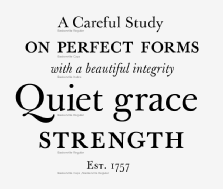John Baskerville
(1707 -
 John Baskerville was born in Wolverley, near Kidderminster in 1707 and moved to Birmingham in 1726. He became skilled in calligraphy, gravestone engraving and then prospered as an experimental manufacturer of fashionable japanned goods from which he was granted the first patent in 1742. With the profits he built a fine house and funded a new printing house.
John Baskerville was born in Wolverley, near Kidderminster in 1707 and moved to Birmingham in 1726. He became skilled in calligraphy, gravestone engraving and then prospered as an experimental manufacturer of fashionable japanned goods from which he was granted the first patent in 1742. With the profits he built a fine house and funded a new printing house.
In 1750 he applied his innovative genius to research into paper making, ink manufacturing, type founding and printing. His experiments into all aspects of printing put him years ahead of his time and did much to advance the industry of his day. From 1757 he printed a famous series of books that placed him among the world’s greatest printers.
They were fine works of exceptional craftsmanship, inventiveness which introduced new concepts in typographic style and new italic styles which broke with traditional old face printing. Combined with his incomparable skill in the layout of pages, Baskerville published the finest-
A Baskerville revival started and today Baskerville fonts are among the world’s most popular and enduring typefaces.
In fearless defiance of English social and religious norms, John Baskerville was openly an atheist-
‘’The most impudent abuse of common sense which ever was invented to befool mankind’’
At his death in 1775, rather than be buried in consecrated ground, he was interred in a mausoleum of his own design, in his own back garden at his house Easy Hill. Subsequently, his land had several owners and in 1820 his body was disinterred during the construction of a canal. Baskerville’s atheism prevented reburial in any church cemetery. The owner of the land, Thomas Gibson, stored his coffin in a warehouse where it could be viewed by the curious for a charge. The body changed hands and was again on display to the public.
cemetery. The owner of the land, Thomas Gibson, stored his coffin in a warehouse where it could be viewed by the curious for a charge. The body changed hands and was again on display to the public.
Eventually in 1829, thanks to an admirer of Baskerville who had a vault in Christ Church in central Birmingham, his body was secretly concealed in the vault and remained there until 1898 when the church was demolished. Baskerville’s body was then reburied in a vault in Warstone Lane -
The genius of John Baskerville is commemorated in Birmingham with a bronze plaque on Baskerville House next to the Library of Birmingham on Broad Street. In 1990 a sculpture by David Patten –‘Industry and Genius’-
The Jewellery Quarter Research Trust would like to thank
Dr.Caroline Archer of The Typographic Hub of
Birmingham City University for her
permission to use material
from the Hub website.
Bronze plaque on
Baskerville House
Birmingham
Click to enlarge

